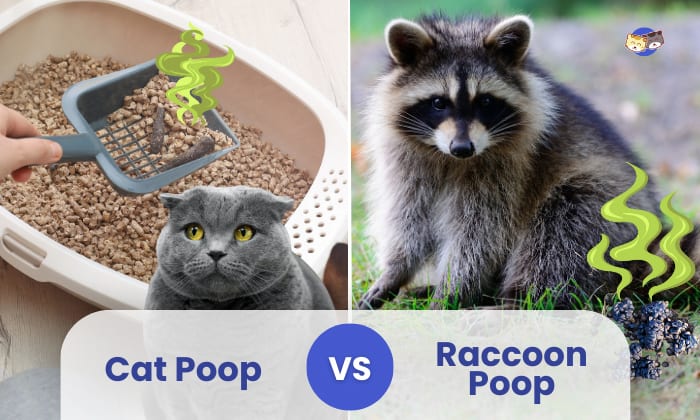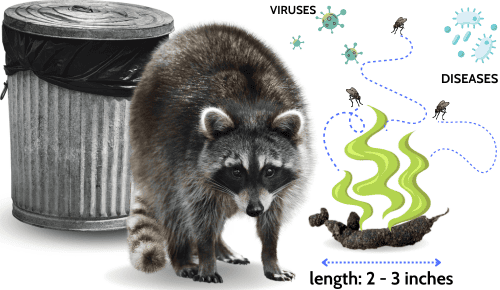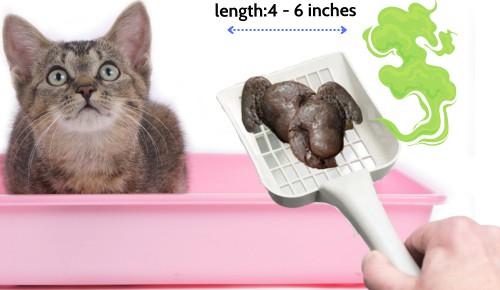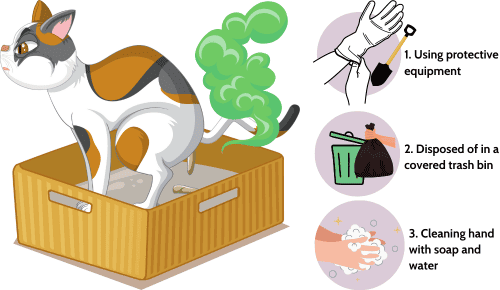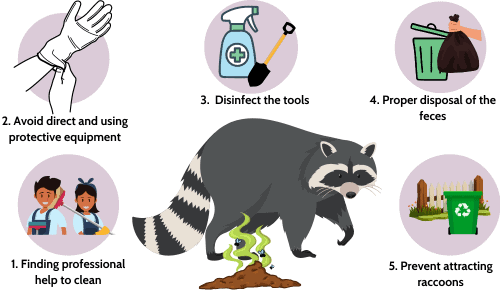Have you ever thought about the difference between cat poop vs raccoon poop? It may seem odd to think about it. Yet, it is important to be aware of the important facts because of the health hazards they pose and to know how to stay safe.
By exploring various aspects– from appearance to health concerns, valuable insights can be learned and could possibly save a life! Read more to know.
Here’s an animal poop identification chart in order to distinguish raccoon poop from cat poop in terms of appearance:
| Characteristics | Cat Poop | Raccoon Poop |
| Shape | Sausage-shaped; cylindrical and segmented | Tubular |
| Color | Brown or Deep brown | Very dark |
| Size | 4 – 6 inches long | 2 – 3 inches long |
| Location | Commonly found on litter boxes | Latrines (like trees, fallen logs, attics, garages, etc.) |
| Texture/Consistency | Malleable (like clay) | Sticky; clumpy |
| Odor | Not too foul but can vary | Strong musky odor |
Table of Contents
Comparing Raccoon Poop vs. Cat Poop
1. Raccoon poop
Raccoons are cat-sized animals that are known to be scavengers of trash cans and eat anything. The black markings on their face may look cute to some. Still, they are an accurate representation of their sneaky attitude, just like bandits, and cause chaos.
That’s why raccoons are urban pests. Their poops are considered “pest poops” because they carry dangerous viruses and diseases.
Generally, raccoon poop is characterized by a tubular shape that measures 2 – 3 inches long. It is very dark in color.
The undigested food remnants, like berries, are the poop identifier that those are raccoon droppings. This can be one important point to differentiate raccoon poops from dog poops.
Despite being destructive urban pests, they have an organized way of relieving themselves. It sets them apart from other animals because they don’t poop wherever they please. Rather they have this so-called latrine site or a place where they go to relieve themselves.
2. Cat poop
Cats can be house pets not, like raccoons, that should only stay outdoors. They are picky eaters and do not eat everything that they see.
This is why cat poop is a helpful indicator of a cat’s health and habits. The waste highly varies on diet, hydration, and overall well-being.
However, a healthy cat poop should generally be light to dark brown in color, malleable consistency, smooth, and sausage-like shape.
It should be segmented and leave minimal traces on the ground when lifted. It can be 4 – 6 six inches in length, thus longer than a racoon’s poopings.
What to Do With Feces Found?
1. Cat Feces
Dealing with cat feces is a usual thing for cat owners. However, most of them tend to overlook the importance of handling it properly.
- Cat poop is one of the culprits for toxoplasmosis because it carries a parasite called Toxoplasma gondii. Toxoplasmosis causes mild flu-like symptoms or none at all among healthy individuals. However, serious cases may arise for immunocompromised and pregnant individuals.
- Zoonotic infections from bacteria such as Salmonella and Campylobacter can also be transmitted from cats to humans. It may lead to gastrointestinal symptoms such as diarrhea, abdominal cramps, vomiting, and fever.
So, it is important to handle cat poop with care.
- Start by using protective equipment such as gloves to avoid direct contact. Use a shovel or scoop to pick up the feces and place it directly in a sealed plastic bag.
- The sealed plastic bag should be disposed of in a covered trash bin to prevent any odors or contamination.
- After handling the feces, wash your hands thoroughly with soap and water to ensure hygiene.
Always remember to clean the cat’s litter box on a daily basis to prevent the accumulation of feces and maintain a clean and safe environment.
2. Raccoon Feces
Regarding dealing with raccoon feces, it requires a different approach due to potential health risks. It is essential to exercise caution and prioritize safety to prevent diseases.
Raccoon scat carries harmful parasites and pathogens.
- One of the most significant parasites is the raccoon roundworm known as Baylisascaris procyonis. It can hurt not just humans but a variety of animals, including dogs.
- This parasite’s egg can be found on raccoon droppings and is highly resilient. These eggs can lead to serious health issues like neurological problems and organ damage if ingested or inhaled.
- Leptospirosis is also one of the zoonotic diseases in raccoons, especially in their urine. It is caused by leptospira bacteria, leading to influenza-like symptoms, severe head and muscle aches, and high fever. In serious cases, it can lead to liver and kidney problems.
- Also consider Giardiasis, a microscopic protozoan infection from raccoon poop, contaminated water, soil, and surfaces. Ingestion of these infected cysts can develop severe gastrointestinal symptoms like stomach cramps and diarrhea.
- Other diseases include Salmonella or E. Coli, fungi, and rare parasites.
Individuals who handle these raccoon feces should take precautionary measures to prevent exposure to infections.
- If you see backyard animal poop and suspect it is raccoon feces, consider seeking professional help for cleanup. They can offer guidance on safe removal procedures.
- Please avoid direct contact by using protective equipment to address it personally to protect yourself from contaminants.
- Make sure to disinfect the tools used to pick up the feces; it’s best to clean them with boiling water and strong disinfectant.
- Proper disposal of the feces.
- In the meantime, take measures how to prevent attracting raccoons. These measures include securing outdoor food sources such as garbage cans and sealing potential entry points like putting up a fence.
Conclusion
In a nutshell, it is crucial to understand cat poop vs raccoon poop, and how to manage them for human and animal well-being properly.
Cat feces can reveal insights of cat’s health, while raccoon feces pose serious zoonotic risks that should be handled with utmost precautions. Proper hygiene, wearing protective gear, and seeking professional help when needed are essential to prevent potential health hazards.
By promoting a clean environment and informed practices, we ensure a safe place for humans and animals while minimizing health concerns.

I am Amy Sawy, a Doctor of Veterinary Medicine (DVM) graduate from the University of Kansas. y husband, Dr. Plummer, and I own a veterinary clinic in Phillipsburg, Kansas. In addition to my professional background, I am a devoted pet owner myself, with a household that includes dogs, rodents, and most notably, cats – a total of five felines in my home.
In 2020, I joined an organization as a professional writer, leveraging my experience and collaborating with my team to deliver the most valuable information for your cat’s care.


